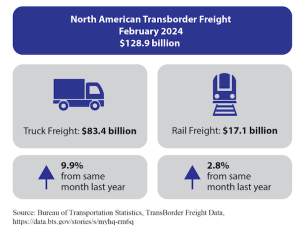In a speech entitled "Railroad-based 'Interstate II,'" delivered to the Fourth Annual Railroad Night at Michigan Technological University in Houghton, Michigan, Gil Carmichael, Founding Chairman of the Board of Directors of the Intermodal Transportation Institute at the University of Denver and a former Federal Railroad Administrator, said the $787 billion economic stimulus package, recently signed by President Barack Obama, is the most ambitious transportation infrastructure program put forth in the U.S. since the 1950s, when President Eisenhower initiated the development of the Interstate Highway System.
"Wrapped inside the $111 billion devoted to much-needed infrastructure spending in his American Recovery and Reinvestment Act, Obama's stimulus plan very significantly allocates $8 billion for intercity high-speed rail transportation and another $1.3 billion for Amtrak," said Carmichael. "This is the first phase of what should be a three-part, high-speed, intercity transportation blueprint that will connect all our major cities, ports and airports via rail," Carmichael told the audience of students, faculty, and representatives from major railroads. "This is the first time an intermodal strategy, with a strong emphasis on rail, has been proposed by government to meet the North American transportation system's requirements for both freight and passenger transport."
Carmichael told the audience this new approach represents the most economical, fuel-efficient, and environmentally sustainable vision for improving our transportation network in this country, and it will help us achieve energy independence. Carmichael calls this new vision of transportation Interstate II, as opposed to the 43,000-mile, four-lane 'Interstate I' Highway System that was begun 50 years ago; and said 'President Obama clearly understands this necessary, new approach to meeting 21st century transportation needs.'
"The nation has enough highways, albeit, most of them are badly in need of repair and suffering from massive gridlock due to a doubling of our population since they were built. What the U.S. does not have is a rail-based, intercity, rail transportation network like that in Europe and Asia. In those parts of the world, where fuel was priced higher, electric high-speed trains carry hundreds of passengers safely and efficiently between cities and connect to and from major airports. North America has a huge rail system already in place, serving 90 states and provinces with 240,000 miles of route. The rights-of-way are already paid for, and the private sector has done much to upgrade them; but they have been vastly under-utilized for years. Our rail system right now carries only 25% of capacity since most of it is single-tracked. By adding 30,000 miles of double- and triple-tracked rail, with grade separations, to our existing system, we can create three times more capacity, connecting millions of people to not only ports, but to airports and center cities, greatly relieving the stress on our overburdened highway system."
Carmichael pointed out that Obama's new infrastructure plan would expand the originally recommended six, intercity, high-speed rail corridors to 13 intercity corridors in phase I and would create developmental partnerships between the private sector and state DOTs. Furthermore, it would be administered by the Federal Railroad Administration, as it should be, and would be fully paid for under the recovery act -- not by matching funds.
He also pointed out that the railroad is the only mode of transportation that easily converts to electricity should the world's fossil fuel supply continue to decline, as many predict. It would also offer a vastly more environmentally friendly and ethical form of transportation, providing nine times the fuel efficiency as highway transportation, while operating at speeds of up to 90 miles-per-hour for freight and up to 125 miles-per-hour for passenger transit. "In the f







